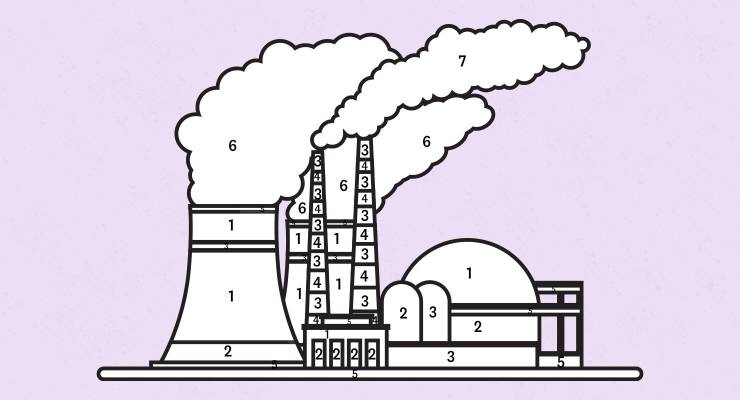
In the latest instalment of Paint by Numbers, Crikey’s new series about the big issues of the day told via the numbers, we lay out the absurdity of the recurring nuclear energy debate.
Years since the Ziggy Switkowski report on nuclear energy for the Howard government: 17.
Years Switkowski predicted it would likely take to build a new nuclear power plant: 15.
The earliest we could open a nuclear power plant, according to former chief scientist Alan Finkel: 2040s.
The latest coal power stations are due to be decommissioned: 2038.
Years since France (the world’s biggest user of nuclear) launched its first atomic reactor: 76.
Years since the UK government announced plans for the Hinkley nuclear power plant: 14.
Projected delay (so far) on completing the Hinkley nuclear power plant: 14 years.
Years since the Chernobyl disaster: 38 (as of April 26).
Years until the immediate zone around Chernobyl is safe to inhabit again: 20,000.
Years since the Fukushima plant disaster: 13.
Years the Fukushima clean-up and decommissioning is set to take: 30-40.
Age of the oldest member of Parliament in Australian history: 90 years.
The age that nuclear advocate Bob Katter will be by the earliest time Australia could open a nuclear power plant: 93.








Number of seats in favour of nuclear facility in their locale and likely to fall to Coalition? Probably zero.
Number of institutional investors who currently invest in nuclear plants elsewhere and who are ready to stump up funds for a project here? Probably zero.
Number of Teals who will be re-elected with stance against nuclear? Probably all who stand.
% of under 35’s who are currently in favour of nuclear power who will fall away when it is pointed out they don’t actually live in America? Lots, but who will dare point this out for fear of losing followers?
% of over 65’s who understand what Bob Kater says who will fall away from nuclear when they realise its a loss maker for their superfund. Lots.
Problem with articles like this that simply promote the themes and tactics of fossil fuels and nuclear to delay transition, but becomes a word of mouth talking point repeated ad nauseam, reinforced, then becomes ‘truthy’ in people’s minds while blocking out discussion of renewable policies; too easy but having significant impact on perceptions of espec. cynical, ageing, low info ALP and related voters…..
Before we have this “conversation”, why doesn’t Dutton help to gather a group of pro nuke advocates to form an energy consortium and stump up with the OWN funds up front to build a full size nuke power station. A conservative $80 billion should do it, the funds to go into a trust account. If they really believe nuke stuff is the answer it shouldn’t be too hard to find the backers.
In 20-25 years, when a nuclear fission plant might be nearly ready to start generating power in Australia (at great cost), it’s highly likely that the challenges of nuclear fusion will be resolved. It’d be embarrassing to start stockpiling our nuclear waste, just as other countries start building fusion power stations that will be waste-free and perfectly safe.
Of course, we’re already using fusion power in Australia (and most of the rest of the world). Given the safety record and low cost of the existing source of fusion where’s the economic advantage in trying to emulate it with a (harmful) radiation emitting local reactor?
Well economic advantages are irrelevant to most things, but practical issue is that we have a growing population (locally and globally), consuming more energy than at any period in human history, and that energy consumption is likely to increase exponentially as we develop more energy consuming technologies like AI and crypto-currencies.
If 2040 is the earliest we’ll have nuclear then that is 16 years from now. 16 years ago…..we didn’t have the iPhone and streaming was only in its infancy.
According to Bloomberg although one iPhone 15 Pro generates 66 kilograms (145 pounds) of carbon dioxide in its lifetime — the equivalent of driving from Washington, DC, to Philadelphia — applying that to all the smartphones Apple shipped in 2022 brings emissions to about 15 million metric tons.
Meanwhile according to something I just Googled “An average person streams, on average, five hours of content a day, resulting in up to 1.57 million tonnes of CO2 emissions released”
That’s just two inventions in the past 15 years.
Solar panels might power our homes (if we can improve battery tech) and possibly even our electric vehicles but they will not be able to power industry base loads. And then ‘economics’ will demand we keep burning fossil fuels.
That’s where hydrogen (created from excess solar power) comes in MH
Hydrogen has a bunch of currently quite difficult problems, particularly around storage and transport. If you don’t have to transport it (use on-site) then that’s probably not too bad. Conversion into ammonia might help with transport. Conversion into e-fuel is even more interesting, IMO, with pilots in Chile at the moment and plans for Tasmania…
If you don’t have to transport it, and energy density isn’t a problem (storage on-site) then various battery, gravity schemes (hydro, cranes) and thermal (molten salt etc) also come into play.
Might be easier to ship it to someone who has a use for it, over the grid. There will be business for enterprises that can be flexible about their energy use, to soak up the “excess” (turning it in to not-excess-after-all).
Base-load is over, in an age of negative spot prices driven by free (over) supply.
The biggest problem for battery storage in transport is the energy to weight ratio (with a side-order of cost, true). Weight is not such a problem for grid-scale storage, so expect to see a lot more flow batteries and lower-density technologies like sulfur, and a lot less lithium. (IMO: reality may ultimately differ.)
But yes, “AI” training infrastructure is using (and is projected to continue to use) a prodigious quantity of electricity. Not quite overtaken crypto, but now in the same ballpark and growing faster. Both combined are still lower cost than all of the rest of the cloud infrastructure. Certainly doesn’t appear that power demand is being turned down any time soon. Will be interesting to see if it can ultimately pay its way, or whether it’ll just go away when the VC-funded bubble breaks.
Power consumption of individual devices (of a certain type and capability) is actually decreasing – why modern laptops have much longer “life” than those of yore. We just seem to keep finding excuses to run bigger and hotter ones, like Fortnight and VR googles and Youtube.
But the problem with energy is that there’s this conflict between the political and technical.
I mean we had the technology 70 years ago to end our reliance on fossil fuels but because of the political (both the fossil fuel industry lobbying and buying governments to kill nuclear and the public’s objections to nuclear (in part driven by disinformation from the fossil fuel industry)) we didn’t take advantage of this technology.
And this was with the full knowledge of climate change (dating back conservatively to the 1950s).
The political reality is that the people who control the energy market will do anything to retain that control. Renewables are a threat to the energy market, nuclear is is now a belated opportunity given it allows them to retain centralised control.
And that’s before you get into the issues you have raised and wishing and hoping energy consumption falls.
Why are you so desperate to have Australia adopt nuclear power in the face of its manifest unfitness for purpose? Is it the same as for Dutton, just a delaying tactic to keep coal going as long as possible?
Climate change is the single biggest challenge humanity has ever faced.
We need to throw everything at it.
If we underestimate our energy needs (as we have for the past 50 years) then we will keep burning fossil fuels (as we have done for the past 50 years).
People like renewables because they believe it’s consequence free energy. Well everything has consequences especially our ever increasing demand for energy.
National electricity use is actually on a slow decline and has been for nearly 15 years.
https://www.aer.gov.au/industry/registers/charts/annual-electricity-consumption-nem
Given the population increase, per-capita consumption is heading down much more sharply.
The electrification of gas appliances and transition to EVs will probably bring it up again (or perhaps just level out the decline), but that wil be a slow transition over 10-20 years (and with vehicle-to-grid actually help level out renewables).
Most developed countries are seeing similar trends.
The AER, like most regulators, are compromised due to
a) 10 years of the Coalition;
b) having close ties to the sector its supposed to regulate (in this case the energy sector that opposes decentralised energy); and
c) human hubris that makes them underestimate the size of the task we’re facing.
But other than that, who doesn’t love statistics that ignore the fact that we burned more fossil fuels last year than any previous year!
So you think the AER has been fabricating data for a quarter century to understate the level of electricity consumption, and this is something that supports the centralised large-scale generation model of nuclear ?
Fossil fuel consumption has also been declining for several years now (in aggregate – gas is up for peaking power, but everything else is down, especially coal):
https://www.energy.gov.au/energy-data/australian-energy-statistics/energy-consumption
I realise the climate issue has changed a few parameters on risk assessment, but it hasn’t changed the engineering and the economics. The ever more tedious refrain “that we need to have a conversation” about it should be met with contempt and scorn, given we have been talking about it since the 1950s.
That said, the Govt should invest, with other nations, in nuclear science and research including its many applications beyond boiling water. It’s a long term investment that because of it’s fundamental science aspect, becomes foundational to most of the hard sciences.
The grid is the main issue these days. The US grid has been hit with a tsunami of new demand. The same will happen here soon. A century from now we will use a 100 times more electricity than we do today and that could be out by a factor of 10. I somehow suspect nuclear physics might play a large part in that, but not quite tomorrow. In the meantime, that solid-state fusion-powered sand-box on ever more rooftops and paddocks – is now the cheapest power on the planet. Go figure!
I have not seen this reported anywhere so far…
In the USA ALL Nuclear Reactors are required by law to have $375Mio in Private Liability insurance coverage.
If they have a claim they can draw on that, plus there’s a Nuclear Industry Insurance Fund guaranteed by other Operators that can provide a further $111Mio.
Seriously, they are massively under-insured meaning ordinary American homeowners and businesses are underwriting the Nuclear Power Industry.
Now, in Australia, a fund of say $500Mio wd only be enough to pay off about 400 families if they had to abandon their homes.
Fukishima now has a “No Fly Zone” of 20km around the plant, the land has been abandoned.
Look at Vales Point, Eraring and Bayswater power stations that the LNP reckons we swap in nuclear – do a radius of 20km and there’s probably 500,000 homes that get abandoned if anyone of those locations had a Fukushima event.
If those power stations are converted to Nuclear, to compete against renewables ($/Mw) the citizen carries the risk, they are effectively uninsurable.
https://www.iii.org/article/insurance-coverage-nuclear-accidents